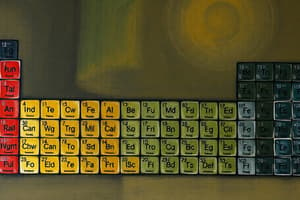Podcast
Questions and Answers
What is the main basis for the modern arrangement of the periodic table?
What is the main basis for the modern arrangement of the periodic table?
- Increasing atomic number (correct)
- Increasing atomic mass
- Increasing electronegativity
- Increasing atomic volume
How does the atomic radius change as you move across a period in the periodic table?
How does the atomic radius change as you move across a period in the periodic table?
- It generally remains constant
- It decreases (correct)
- It becomes unpredictable
- It increases
What trend is observed in ionization energy as you move down a group in the periodic table?
What trend is observed in ionization energy as you move down a group in the periodic table?
- It increases
- It decreases (correct)
- It stagnates
- It remains unchanged
According to periodic trends, what happens to electronegativity as you move across a period?
According to periodic trends, what happens to electronegativity as you move across a period?
Which of the following statements best describes the metallic character of elements as you move across a period?
Which of the following statements best describes the metallic character of elements as you move across a period?
Flashcards are hidden until you start studying
Study Notes
Periodic Law
-
Definition: The Periodic Law states that the properties of elements are a periodic function of their atomic numbers.
-
Historical Context:
- Proposed by Dmitri Mendeleev in the 19th century.
- Mendeleev arranged elements in order of increasing atomic mass, leading to the periodicity of elements.
-
Modern Interpretation:
- With the discovery of atomic structure, the law is more accurately defined in terms of atomic numbers rather than atomic masses.
- The modern periodic table is arranged by increasing atomic number (number of protons).
-
Periodic Trends:
- Atomic Radius: Generally decreases across a period (left to right) and increases down a group.
- Ionization Energy: Increases across a period and decreases down a group.
- Electronegativity: Increases across a period and decreases down a group.
- Metallic Character: Decreases across a period and increases down a group.
-
Conclusion: The organization of the periodic table based on atomic numbers reveals patterns and trends that reflect the chemical behavior of the elements, providing a systematic way to study their properties.
Periodic Law
- The Periodic Law states that the properties of elements repeat in a regular pattern as their atomic numbers increase.
- Dmitri Mendeleev arranged elements in order of increasing atomic mass, leading to the discovery of the periodicity of elements.
- The modern Periodic Table is arranged by increasing atomic number, which represents the number of protons in an atom.
- Atomic Radius generally decreases across a period and increases down a group.
- Ionization Energy, which is the energy required to remove an electron from an atom, increases across a period but decreases down a group.
- Electronegativity, representing an atom's ability to attract electrons, increases across a period and decreases down a group.
- Metallic Character, describing an element's ability to lose electrons and form positive ions, decreases across a period and increases down a group.
Conclusion
- The organization of the periodic table based on atomic numbers reveals patterns and trends in the chemical behavior of the elements, providing a systematic way to study their properties.
Studying That Suits You
Use AI to generate personalized quizzes and flashcards to suit your learning preferences.




